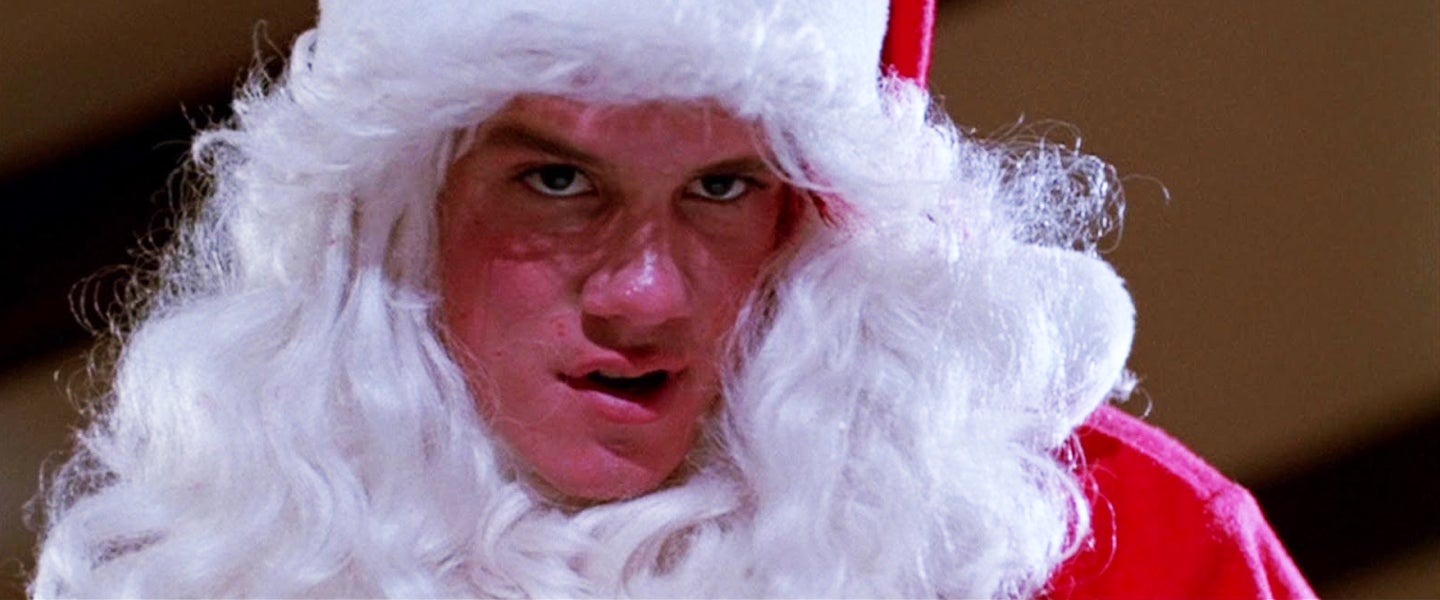Scandal Cinema is an occasional column looking back at some of the most controversial movies in film history and considering how they play today.
On November 8th, 1984, some concerned Milwaukee residents took to the streets to protest a movie that hadn’t yet been released. Led by Kathleen Eberhardt, a mother of two, the quickly formed Citizens Against Movie Madness had grown alarmed after watching ads for the upcoming TriStar release Silent Night, Deadly Night during a Green Bay Packers game, ads that started with a few lines from the holiday staple “A Night Before Christmas” then featured images of a man in a Santa suit wielding an axe and holding a gun. “You made it through Halloween,” they warned. “Now try and survive Christmas.” It was not, to put mildly, the sort of thing parents were used to watching with their kids on a Sunday afternoon.
Protests against the film, well, snowballed. The controversy around Silent Night, Deadly Night became a national story covered by Dan Rather on CBS Evening News and the outrage spread across the country. One Brooklyn theater attracted a reported 200 protesters on November 12th, the Monday after the film opened, some carrying signs reading “Santa’s Not a Hitman” and “Deck the Halls With Holly, Not Bodies.” TriStar had opened the film in 400 theaters with plans to expand the release as Christmas neared. Those plans didn’t work out.
By November 15th, the studio pulled all TV ads for the movie. It disappeared from theaters shortly thereafter.
Gone for good? Not exactly, but we’ll get to that.
First, it’s worth exploring how the controversy happened in the first place. What was it about this movie, of all the slasher films that flooded theaters in the early ’80s, that set off such an uproar. There’s a short answer and a long one.
The short one is simple: It’s Santa doing the killing. Well, not exactly Santa. But it is someone wearing a Santa costume. And for unsuspecting viewers settling in for a football game with their kids, that might have been enough to set them off picketing. “I have a very impressionable 3-year-old child,” Bronx mom Denise Giordano told People. “On Christmas he expects Santa to come down the chimney with gifts. In this ad a man in a Santa suit comes with an axe. I can’t imagine a child seeing that and not being frightened.”
But Silent Night, Deadly Night was also the culmination of a trend. The years after Halloween saw one slasher film after another hit theaters, most of them copying their inspiration in broad strokes without the skill and wit that made the original great. They also upped the gore and raised concerns about misogyny. “These films hate women,” critic Roger Ebert said in a 1980 episode of Sneak Previews dedicated to slasher films. “And, unfortunately, the audiences that go to them don’t seem to like women too much either.”
Years later, that seems too simple a claim to make about the entirety of slasher films, whose mix of sex and violence often contain complex attitudes that can’t be boiled down to a hatred of women. And it’s certainly too broad a claim to make of those who watched slasher films, and watch them still. But it’s not hard to see where Ebert was coming from, either. Subjected as he and his partner Gene Siskel were to a weekly barrage of rape and murder, it might have been hard not to feel like horror movies were trying to find a new low.
It’s also easy to see how many thought they’d found it four years later, with a film about a killer Santa. But does the film itself bear that out? Well, kind of, actually.
Put simply, Silent Night, Deadly Night isn’t a very good movie, even by the relaxed standards of the slasher film. Shot on an obviously modest budget in small, visibly thawing Utah town the previous February, it’s made without much flair, as if director Charles E. Sellier Jr. — a veteran low-budget producer better known for the Grizzly Adams series and questionable “documentaries” about religion and history — was just dutifully trudging his way from one kill to the next.
It’s also grim stuff, even by those standards, featuring lingering shots of nude bodies getting sliced open and staging much of its violence in the presence of children. In one scene, the killer Santa hands a little girl in a bloody knife. In the finale, he gets gunned down as the residents of an orphanage looks on in horror. It revels in being distasteful but doesn’t leaven its distastefulness with any kind of cleverness, unless watching a character being killed by Christmas lights counts.
Beyond this, it’s driven by a sense of fatalistic hopelessness. In the opening scenes, set in 1971, a kid named Billy watches as his parents are killed by a thief in a Santa costume. Sent to an orphanage run by a fierce nun, he has his head filled with guilty feelings about sex. Years later, while working at a toy store, he’s asked to don a Santa costume, gets horny around a co-worker and, voilà, a killer Santa is born. By the film’s reckoning, we’re fated to repeat the worst traumas inflicted on us as kids. One moment you’re stocking the shelves with Star Wars toys and Masters of the Universe play sets. The next you’re impaling ’80s scream queen Linnea Quigley on some antlers and there’s nothing you can do about it. It’s less scary than depressing.
Robert Brian Wilson, who played the killer Santa, brought his father to the premiere. “Afterward,” he told MEL last year, “my dad looked at me like, ‘What in the hell have you done?’”
Did the film deserve the sort of outcry it served? Not really. TriStar’s biggest mistake wasn’t making a killer Santa movie, but pushing it so hard and and to the wrong audience. Silent Night, Deadly Night wasn’t even unprecedented. There had been Christmas horror movies before, like Bob Clark’s great 1974 film Black Christmas. There had even been killer Santa movies. 1980 produced two of them, To All a Good Night and Christmas Evil (the latter a memorably bizarre outing that, unlike Silent Night, Deadly Night, rewards those who seek it out).
What’s more, by striking down Silent Night, Deadly Night, the protests only made it stronger. The film returned to theaters that spring, drafting off the controversy. It then became a huge hit in video stores, inspiring four sequels (including one directed by Two-Lane Blacktop’s Monte Hellman and another starring Mickey Rooney), and a loose remake entitled Silent Night. Outside the franchise, others have run with the idea of the killer Santa. A short list from recent years: Santa’s Slay, Christmas Slay, Good Tidings (which features three killer Santas), All Through the House, and so on, all of them popping up on streaming services without much fanfare, or any protest.
The worst nightmares of ’80s Milwaukee moms are now just a click away.

